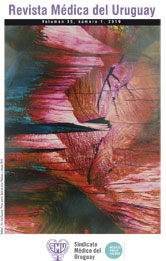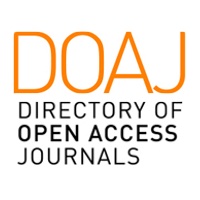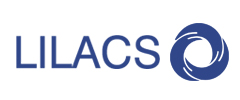Treatment of cancer of the anal canal. Description of technique and results of radiation therapy with or without chemotherapy
Retrospective study in a non-selected population (1988 - 2016)
Abstract
Introduction: cancer of the anal canal accounts for approximately 2 to 3% of all digestive neoplasms. Nigro described the conservative treatment of cancer of the anal canal using radiation and chemotherapy of 5-fluorouracil (5-FU) and mitomycin-C (MMC). Since then, this is the standard therapy.
Objective: to describe the technique used in our service and its results in the locoregional follow up of cancer of the anal canal.
Method: descriptive, longitudinal, retrospective. The medical history of 72 consecutive patients with no exclusions, who were carriers of cancer of the anal canal were analysed between 1988 and 2016. 67% underwent radiation and chemotherapy and 33% only radiation therapy due to specific medical contraindications. All cases were comprehensively studied and no interruption of treatments were planned. Mandatory interruptions were from 1 to 17 days long and average length was 3 days. Severe reactions were moderate and no late complications were seen. All patients underwent locoregional radiation therapy.
Results: local control in N0 was 86% in T1 and T2 versus 42% in T3 and T4 after 6 years p=0,01 meaningful.
Conclusions: radiation therapy with the technique used in our service is effective to treat cancer of the anal
References
(1) Siegel RL, Millar KD, Jemal A. Cancer statistics, 2016. CA Cancer J Clin 2016; 66(1):7-30. Disponible en: http://onlinelibrary.wiley.com/doi/10.3322/caac.21332/epdf. Consulta: 14 julio 2017.
(2) Barrios E. Incidencia del cáncer en Uruguay. Período 2007-2011. Montevideo: CHLCC, 2015.
(3) Frisch M, Glimelius B, van den Brule AJ, Wohlfahrt J, Meijer CJ, Walboomers JM, et al. Sexually transmitted infection as a cause of anal cancer. N Engl J Med 1997; 337(19):1350-8. Disponible en: http://www.nejm.org/doi/full/10.1056/NEJM199711063371904#t=article. Consulta: 19 julio 2017.
(4) Netter FH. Atlas of human anatomy. 6th. Philadelphia, PA: Elsevier, 2014:371p.
(5) Webb SP, Lee CS. Epidermoid cancer of the anal canal. Clin Colon Rectal Surg 2011; 24(3):142-8. DOI: 10.1055/ s-0031-1285998.
(6) CHLCC. Incidencia del cáncer en el Uruguay: 2007-2011 Incidencia del cáncer del canal anal. Montevideo, 2017.
(7) Nigro ND, Vaitkevicius VK, Considine B Jr. Combined therapy for cancer of the anal canal: a preliminary report. Dis Colon Rectum 1974; 17(3):354-6.
(8) Clifford Chao K, Shab AA. Anal canal. En: Clifford Chao K, Pérez C, Brady L, eds. Radiation oncology: management decisions. 3rd ed. Philadelphia, PA: Wolters Kluwer, 2011:455-68.
(9) Torres M, Avondet I, Vazquez J, Santini AE. Cáncer del canal anal. Una neoplasia radioquimiocurable. Cir Urug 1997; 67:140-9.
(10) Torres M. Tratamiento conservador del carcinoma epidermoide del canal anal con radioquimioterapia concomitante: experiencia 1989-2000. Rev Oncol 2002; 4(7):370-7.
(11) Joiner M, van der Kogel A, eds. Basic clinical radiobiology. 4 ed. Londres: Hodder Arnold, 2009.
(12) Fowler JF. The linear-quadratic formula and progress in fractionated radiotherapy. Br J Radiol 1989; 62:679-94.
(13) Glimelius B, Pahlman L. Radiation therapy of anal epidermoid carcinoma. Int J Radiat Oncol Biol Phys 1987; 13(3):305-12.
(14) Kachnic L, Winter K, Myerson RJ, Goodyear MD, Willins J, Esthappan J, et al. RTOG 0529: a phase 2 evaluation of dose-painted intensity modulated radiation therapy in combination with 5-fluorouracil and mitomycin-C for the reduction of acute morbidity in carcinoma of the anal canal. Int J Radiation Oncol Biol Phys 2013; 86(1):27-33. DOI: 10.1016/ j.ijrobp.2012.09.023.
(15) Myerson RJ, Garofalo MC, El Naqa I, Abrams RA, Apte A, Bosch WR, et al. Elective clinical target volumens for conformal therapy in anorectal cancer: a radiation therapy oncology group consensus panel contouring atlas. Int J Radiat Oncol Biol Phys 2009; 74(3):824-30.
(16) Asociación Médica Mundial. Declaración de Helsinki. Principios éticos para las investigaciones médicas en seres humanos. Edimburgo: AMM, 2000.
(17) Uruguay. Poder Judicial. Decreto de Ley Nº 379/008. Investigaciones con seres humanos. Diario Oficial nº 27547 (14 agosto 2008):415-A.
(18) Uruguay. Poder Judicial. Ley No 18.331. Protección de datos personales y acción de “Habeas Data”. Diario Oficial nº 27549 (18 agosto 2008):437-A.
(19) Glynne-Jones R, Rao S. Treatment of the primary tumor in anal canal cancers. Sur Oncol Clin N Am 2017; 26(1):73-90. DOI: 10.1016/j.soc.2016.07.003.
(20) Das P, Bathia S, Eng C, Ajani JA, Skibber JM, Rodriguez-Bigas MA, et al. Predictors and patterns of recurrence after definitive chemoradiation for anal canal cancer. Int J Radiat Oncol Biol Phys 2007; 68(3):794-800.
(21) Wright JL, Patil SM, Temple LK, Minsky BD, Saltz LB, Goodman KA. Squamous cell carcinoma of the anal canal: patterns and predictors of failure and implications for intensity-modulated radiation treatment planning. Int J Radiat Oncol Biol Phys 2010; 78(4):1064-72.
(22) Northover J, Glynne-Jones R, Sebag-Montefiore D, James R, Meadows H, Wan S, et al. Chemoradiation for the treatment of epidermoid anal cancer: 13-year follow-up of the first randomised UKCCCR Anal Cancer Trial (ACT I). Br J Cancer 2010; 102(7):1123-8.
(23) Sebag-Montefiore D, James R, Meadows H, Begum R, Cunningham D, Northover J, et al. The pattern and timing of disease recurrence in squamous cancer of the anus: mature results from the NCRI ACT II trail. J Clin Oncol 2012; 30(15 Suppl):4029.
(24) Bartelink H, Roelofsen F, Eschwege F, Rougier P, Bosset JF, Gonzalez DG, et al. Concomitant radiotherapy and chemotherapy is superior to radiotherapy alone in the treatment of locally advanced anal cancer: results of a phase III randomized trail of the European Organization for Research and Treatment of Cancer Radiotherapy and Gastrointestinal Cooperative Groups. J Clin Oncol 1997; 15(5):2040-9.
(25) UKCCCR Anal Cancer Trial Working Party. Epidermoid anal cancer: results from the UKCCCR randomised trial of radiotherapy alone versus radiotherapy, 5-fluorouracil, and mitomycin. Lancet 1996; 348(9034):1049-54.
(26) Spithoff K, Cummings B, Jonker D, Biagi JJ. Chemoradiotherapy for squamous cell cancer of the anal canal: a systematic review. Clin Oncol (R Coll Radiol) 2014; 26(8):473-87. DOI: 10.1016/j.clon.2014.03.005.
(27) Glynne-Jones R, Sebag-Montefiore D, Adams R, McDonald A, Gollins S, James R, et al. “Mind the gap”—the impact of variations in the duration of the treatment gap and overall treatment time in the first UK Anal Cancer Trial (ACT I). Int J Radiat Oncol Biol Phys 2011; 81(5):1488-94.
(28) Herman JM, Thomas CR. RTOG 0529: intensity modultated radiation therapy and anal cancer, a step in the right direction? Int J Radiat Oncol Biol Phys 2013; 86(1):8-10.
(29) Gunderson L, Moughan J, Ajani JA, Pedersen JE, Winter KA, Benson AB 3rd, et al. Anal carcinoma: impact of TN category of disease on survival, disease relapse, and colostomy failure in US Gastrointestinal Intergroup RTOG 98-11 phase 3 trial. Int J Radiat Oncol Biol Phys 2013; 87(4):638-45.

This work is licensed under a Creative Commons Attribution-NonCommercial 4.0 International License.













